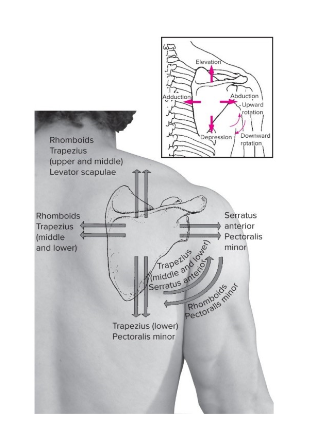Kin Exam Review Part 1
1/39
There's no tags or description
Looks like no tags are added yet.
Name | Mastery | Learn | Test | Matching | Spaced |
|---|
No study sessions yet.
40 Terms
What is the joint classification of the Sternoclavicular joint in the shoulder girdle?
Arthrodial joint (aka plane joint); Multiaxial
What kind OR how many axis of movement does the sternoclavicular joint in the shoulder girdle have?
Multiaxial movement
What is the joint classification of the Acromioclavicular joint in the shoulder girdle?
Arthrodial joint (aka plane joint)
What is the joint classification of the Scapulothoracic joint in the shoulder girdle?
False joint
Is the Scapulothoracic joint in the shoulder girdle a true joint?
No, the Scapulothoracic joint is a False joint.
What is the joint classification of the Glenohumeral joint in the shoulder joint?
Enarthrodial joint; Moves in all planes/most moveable in body; Most complex; Multiaxial; Ball and socket joint.
What are the 5 characteristics of the glenohumeral joint in the shoulder joint?
Include:What kind of joint it is
How it moves
If it is complex or not
what type and axes of movement it has
The glenohumerual joint is a enarthrodial joint, most movable in the body, complex, and multiaxial and ball and socket joint
Among shoulder joints, which one is the most complex?
The Glenohumeral joint is the most complex shoulder joint.
What is the joint classification of the Humeroulnar joint in the elbow joint?
Hinge joint; Permits a wide range of movement in one plane
What movement does the humeroulnar joint in the elbow allow?
Wide range of movement in one plane
What is the joint classification of the Radioulnar joint in the elbow joint?
Pivot joint (aka a trochoid joint); Degrees of freedom: 1
How many degrees of freedom does the Radioulnar joint have in the elbow joint?
1
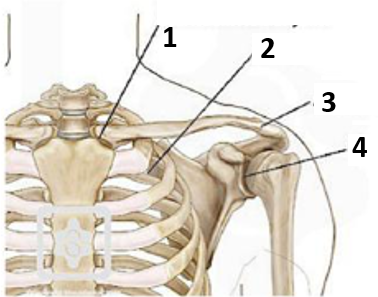
What Joint is number 1 picture
Sternoclavicular joint
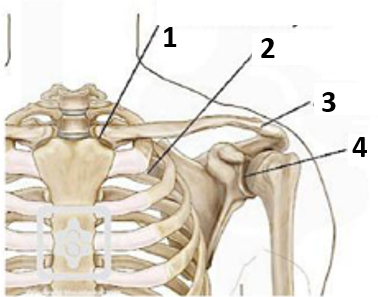
What Joint is number 2 in the picture
Scapulothoracic joint

What Joint is number 3 in the picture
Acromioclavicular joint

What Joint is number 4 in the picture
Glenohumeral joint

Which number indicates the Acromioclavicular joint?
3
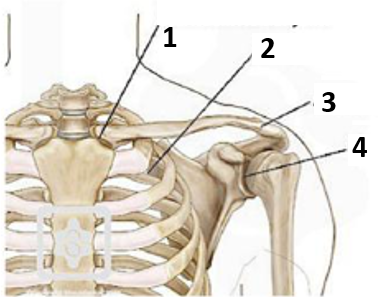
Which number indicates the sternoclavicular joint?
1
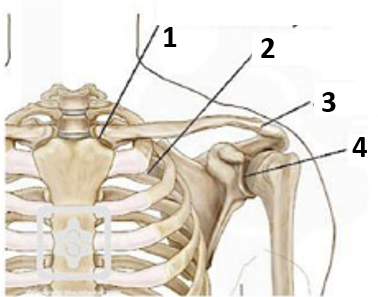
What number indicates the glenohumeral joint?
4
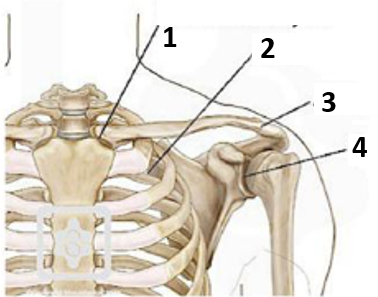
what number indicates the scapulothoracic joint?
2

What is number 1 in the picture
Humerus
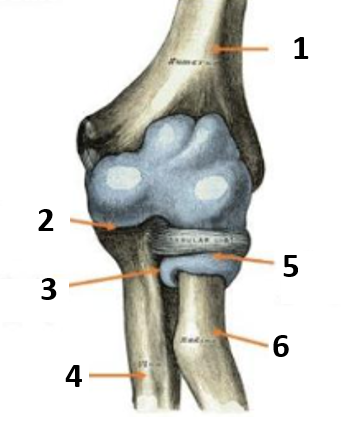
What joint is number 2 in the picture
Humeroulnar joint aka hinge joint
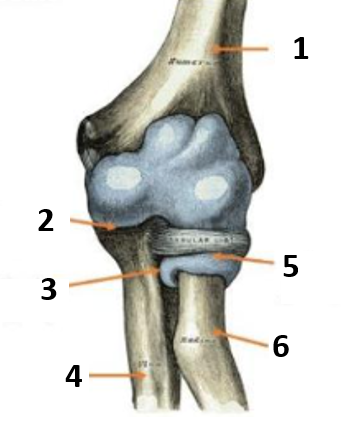
What joint is number 3 in the picture
Proximal radio-ulnar joint aka pivot joint
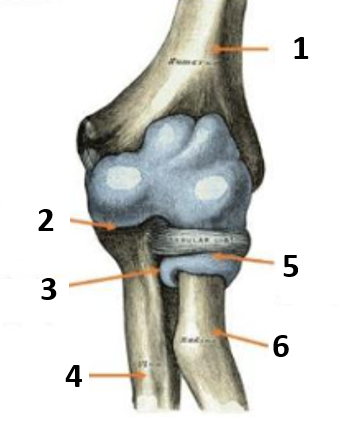
What is number 4 in the picture
Ulna
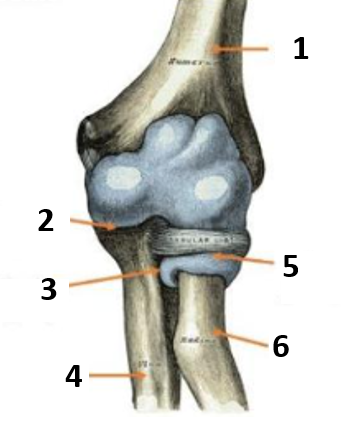
What joint is number 5 in the picture
Humeroradial joint aka hinge joint
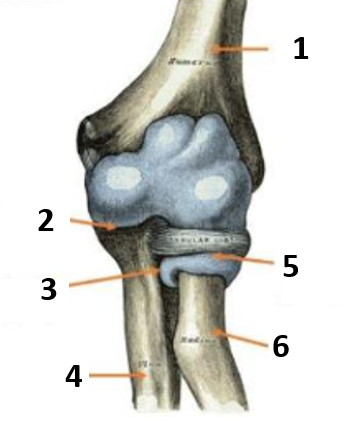
what is number 6 in the picture
radius
What are the three joints that make up the shoulder girdle?
Sternoclavicular, Acromioclavicular, Scapulothoracic
Sternoclavicular, Acromioclavicular, Scapulothoracic are the three joints that make up what
shoulder girdle
What is the relationship between movements at the shoulder joint and the shoulder girdle?
The shoulder joint and shoulder girdle work together in carrying out upper-extremity activities.
Is the shoulder girdle dependent on the shoulder joint?
No, the shoulder girdle is not dependent solely on the shoulder joint.
Why are muscles of the shoulder girdle important?
Muscles of the shoulder girdle are essential in providing a scapula stabilizing effect. This stabilization ensures that the shoulder joint has a stable base to exert force for powerful movements.
What are the 5 major muscles of the shoulder girdle?
HINT: Mnemonic to help remember the 5 major muscles: The Strong Rhinoceros Prefers Lemons
Trapezius, serratus anterior, rhomboids, pectoralis minor, and levator scapulae
Trapezius, serratus anterior, rhomboids, pectoralis minor, and levator scapulae are the 5 major muscles of what
Shoulder girdle

List the Origin, Insertion, Actions, and Antagonist of the Levator Scapulae of the SHOULDER GIRDLE
Origin: Transverse processes of superior/upper 4 cervical vertebrae
Insertion: Medial border of scapular (from superior angle to scapular spine)
Action(s): Elevation, weak downward rotation, weak adduction
Antagonist: Lower fibers of trapezius and pectoralis minor
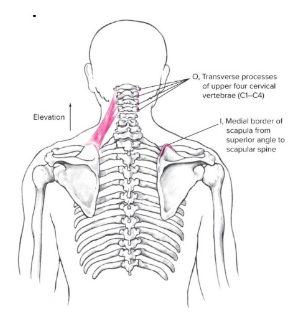
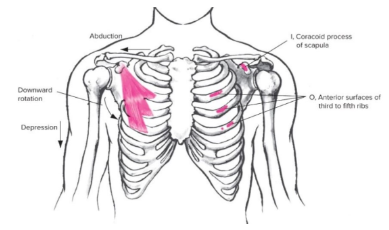
List the Origin, Insertion, Actions, and Antagonist of the Pectoralis Minor of the SHOULDER GIRDLE
Origin: Anterior surfaces of 3rd to 5th ribs
Insertion: coracoid process of scapula
Action(s): abduction, downward rotation, or depression
Antagonist: Trapezius (upper and lower fibers) and Serratus Anterior (lower fibers)
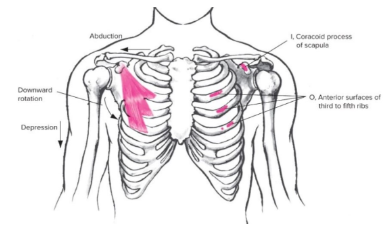
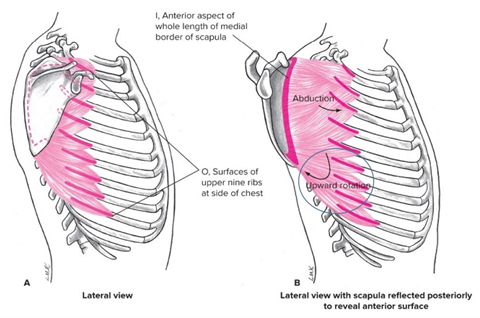
List the Origin, Insertion, Actions, and Antagonist of the Serratus Anterior of the SHOULDER GIRDLE
Origin: Surface of upper 9 ribs at the side of the chest
Insertion: anterior surface of medial border of scapula
Action(s): Abduction (protraction) and upward rotation
Antagonist: Trapezius, rhomboid*
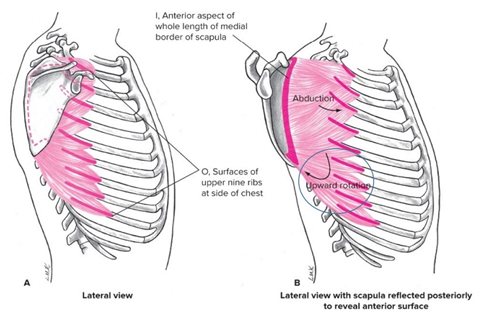
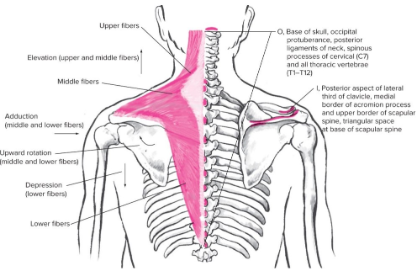
List the Origin, Insertion, Actions, and Antagonist of the Trapezius (SLP Major) of the SHOULDER GIRDLE
Origin: occipital bone- T12
Upper: Occipital bone
Middle: Spinous process 7th cervical and upper 3 thoracic vertebrae
Lower: 4th-12th thoracic vertebrae
Insertion: posterior lateral ⅓ of clavicle, acromion process, scapular spine
Action(s):
Upper fibers: elevation, upwards rotation (weaker)
Middle fibers: elevation, upward rotation, retraction (stronger)
Lower fibers: depression, retraction (weaker)
Together: pull upward and retract simultaneously
Antagonist:
serratus anterior muscle,
latissimus dorsi,
pectoralis MAJOR*
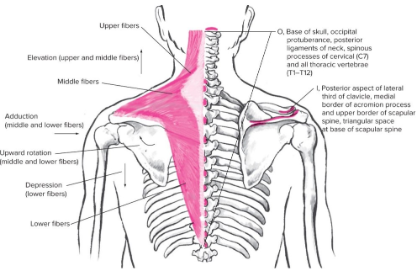
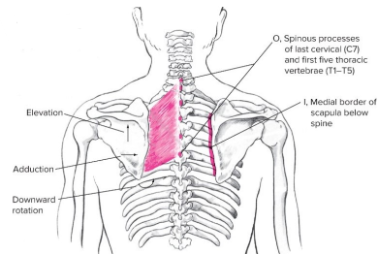
List the Origin, Insertion, Actions, and Antagonist of the Rhomboid (STP MINOR) of the SHOULDER GIRDLE
Origin: Spinous processes of the 7th cervical and first 5 thoracic vertebrae
Insertion: medial border of scapula, inferior to the scapular spine
Action(s): Adduction (retraction), downward rotation, elevation
Antagonist:
Serratus
Trapezius,
Pectoralis MINOR*
